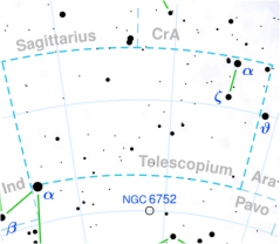Astronomy:HD 178845
| Observation data {{#ifeq:J2000.0 (ICRS)|J2000.0 (ICRS)|Epoch J2000.0 Equinox J2000.0 (ICRS)| [[History:Epoch|Epoch J2000.0 (ICRS)]] [[Astronomy:Equinox (celestial coordinates)|Equinox J2000.0 (ICRS)}} | |
|---|---|
| Constellation | Telescopium |
| A | |
| Right ascension | 19h 12m 46.13847s[1] |
| Declination | −50° 29′ 11.1095″[1] |
| Apparent magnitude (V) | 6.13[2] |
| B | |
| Right ascension | 19h 12m 45.51968s[3] |
| Declination | −50° 29′ 08.7448″[3] |
| Apparent magnitude (V) | 10.90±0.02[4] |
| Characteristics | |
| A | |
| Spectral type | G8 III[5] |
| B−V color index | +0.95[2] |
| Astrometry | |
| A | |
| Radial velocity (Rv) | −26.4±0.4[6] km/s |
| Proper motion (μ) | RA: +44.868[1] mas/yr Dec.: −42.034[1] mas/yr |
| Parallax (π) | 8.6125 ± 0.0283[1] mas |
| Distance | 379 ± 1 ly (116.1 ± 0.4 pc) |
| Absolute magnitude (MV) | +0.68[7] |
| B | |
| Radial velocity (Rv) | −24.2±5.3[8] km/s |
| Proper motion (μ) | RA: +46.984 mas/yr Dec.: −41.403 mas/yr |
| Parallax (π) | 8.6162 ± 0.024[3] mas |
| Distance | 379 ± 1 ly (116.1 ± 0.3 pc) |
| Details[9] | |
| A | |
| Mass | 2.35±0.08 M☉ |
| Radius | 9.13±0.16 R☉ |
| Luminosity | 47±0.9 L☉ |
| Surface gravity (log g) | 2.95±0.10 cgs |
| Temperature | 5,001±36 K |
| Metallicity [Fe/H] | +0.02±0.03 dex |
| Rotational velocity (v sin i) | 2.6±1.1[10] km/s |
| Age | 455+45−46[1] Myr |
| Other designations | |
| Database references | |
| SIMBAD | data |
HD 178845, also known as HR 7271 or rarely 49 G. Telescopii, is a binary star located in the southern constellation Telescopium. Gaia DR3 parallax measurements place the system 379 light years away[3][1] and both components are approaching the Solar System with heliocentric radial velocities of −26 km/s and −24 km/s respectively.[6][8] At its current distance, HD 178845A's brightness is diminished by 0.22 magnitudes due to interstellar dust.[11]
The primary has an apparent magnitude of 6.13,[2] placing it near the naked eye viewing limit and the companion has an apparent magnitude of 10.9,[4] making it readily visible in medium-sized telescopes. The system was first observed by astronomer Willem Hendrik van den Bos in 1930.[12] As of 1991, HD 178845B is located 7.2" away along a position angle of 320°.[13]
The primary is an evolved red giant with a stellar classification of G8 III.[5] It has 2.35 times the mass of the Sun[9] but at the age of 455 million years,[1] it has expanded to 9.1 times its radius.[9] It radiates 47 times the luminosity of the Sun from its enlarged photosphere at an effective temperature of 5,001 K,[9] giving it a yellow hue. It has a solar metallicity ([Fe/H] = +0.02[9]) and spins modestly with a projected rotational velocity of 2.6 km/s.[10]
References
- ↑ 1.0 1.1 1.2 1.3 1.4 1.5 1.6 Vallenari, A. et al. (2022). "Gaia Data Release 3. Summary of the content and survey properties". Astronomy & Astrophysics. doi:10.1051/0004-6361/202243940 Gaia DR3 record for this source at VizieR.
- ↑ 2.0 2.1 2.2 Johnson, H. L.; Mitchell, R. I.; Iriarte, B.; Wisniewski, W. Z. (1966). "UBVRIJKL Photometry of the Bright Stars". Communications of the Lunar and Planetary Laboratory 4: 99–110. Bibcode: 1966CoLPL...4...99J.
- ↑ 3.0 3.1 3.2 3.3 Vallenari, A. et al. (2022). "Gaia Data Release 3. Summary of the content and survey properties". Astronomy & Astrophysics. doi:10.1051/0004-6361/202243940 Gaia DR3 record for this source at VizieR.
- ↑ 4.0 4.1 Høg, E.; Fabricius, C.; Makarov, V. V.; Urban, S.; Corbin, T.; Wycoff, G.; Bastian, U.; Schwekendiek, P. et al. (March 2000). "The Tycho-2 catalogue of the 2.5 million brightest stars". Astronomy and Astrophysics 355: L27–L30. ISSN 0004-6361. Bibcode: 2000A&A...355L..27H.
- ↑ 5.0 5.1 Houk, Nancy (1978). Michigan catalogue of two-dimensional spectral types for the HD stars: Declinations −53° to −40°. 2. Bibcode: 1978mcts.book.....H.
- ↑ 6.0 6.1 Gontcharov, G. A. (November 2006). "Pulkovo Compilation of Radial Velocities for 35,495 Hipparcos stars in a common system". Astronomy Letters 32 (11): 759–771. doi:10.1134/S1063773706110065. ISSN 1063-7737. Bibcode: 2006AstL...32..759G.
- ↑ Anderson, E.; Francis, Ch. (May 2012). "XHIP: An extended hipparcos compilation". Astronomy Letters 38 (5): 331–346. doi:10.1134/S1063773712050015. ISSN 1063-7737. Bibcode: 2012AstL...38..331A.
- ↑ 8.0 8.1 Brown, A. G. A. (August 2018). "Gaia Data Release 2: Summary of the contents and survey properties". Astronomy & Astrophysics 616: A1. doi:10.1051/0004-6361/201833051. Bibcode: 2018A&A...616A...1G. Gaia DR2 record for this source at VizieR.
- ↑ 9.0 9.1 9.2 9.3 9.4 Ottoni, G.; Udry, S.; Ségransan, D.; Buldgen, G.; Lovis, C.; Eggenberger, P.; Pezzotti, C.; Adibekyan, V. et al. (January 2022). "CORALIE radial-velocity search for companions around evolved stars (CASCADES): I. Sample definition and first results: Three new planets orbiting giant stars". Astronomy & Astrophysics 657: A87. doi:10.1051/0004-6361/202040078. ISSN 0004-6361. Bibcode: 2022A&A...657A..87O.
- ↑ 10.0 10.1 De Medeiros, J. R.; Alves, S.; Udry, S.; Andersen, J.; Nordström, B.; Mayor, M. (January 2014). "A catalog of rotational and radial velocities for evolved stars V: Southern stars". Astronomy & Astrophysics 561: A126. doi:10.1051/0004-6361/201220762. ISSN 0004-6361. Bibcode: 2014A&A...561A.126D.
- ↑ Gontcharov, George A.; Mosenkov, Aleksandr V. (28 September 2017). "Verifying reddening and extinction for Gaia DR1 TGAS main sequence stars". Monthly Notices of the Royal Astronomical Society 472 (4): 3805–3820. doi:10.1093/mnras/stx2219. ISSN 0035-8711. Bibcode: 2017MNRAS.472.3805G.
- ↑ van den Bos, W. H. (May 1930). "New southern double stars, tenth list". Bulletin of the Astronomical Institutes of the Netherlands 5: 179. ISSN 0365-8910. Bibcode: 1930BAN.....5..179V.
- ↑ Mason, Brian D.; Wycoff, Gary L.; Hartkopf, William I.; Douglass, Geoffrey G.; Worley, Charles E. (December 2001). "The 2001 US Naval Observatory Double Star CD-ROM. I. The Washington Double Star Catalog". The Astronomical Journal 122 (6): 3466–3471. doi:10.1086/323920. ISSN 0004-6256. Bibcode: 2001AJ....122.3466M.
<ref> tag with name "Gould1879" defined in <references> is not used in prior text.
 |


